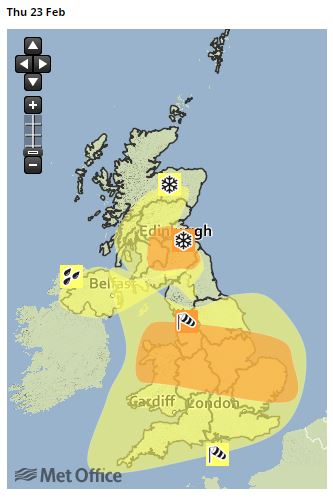The Met Office have updated their (09:45) Amber Warning of Wind – Valid from 06:00 on Thu, 23rd Feb 2017 until 20:00 on Thu, 23rd Feb 2017
Some very strong winds are expected on Thursday in association with storm ‘Doris’ with gusts of 60-70 mph likely, and 70-80 mph on coasts and hills.
Whilst the strongest winds look to be only short-lived, some damage to structures (e.g. dislodged tiles), with a danger of injury from flying debris. Interruptions to power supplies and widespread disruption to travel networks are likely, Trees are also likely to be damaged or blown over.
Heavy rain is also likely through Thursday as well as some snow over high ground as the system clears eastwards. These may prove additional hazards.
The warning has been updated to extend the at-risk area southwards. For more details please go to: http://www.metoffice.gov.uk/public/weather/warnings. And
http://www.metoffice.gov.uk/guide/weather/severe-weather-advice#Wind
Details for general public guidance can be found on the Met Office Website and the Suffolk Resilience Forum Severe Weather Response Plan (Page 29 extract below).
STORMS AND GALES
Before the storm
Secure loose objects such as ladders, garden furniture or anything else that could be blown into windows and other glazing and break them.
- Close and securely fasten doors and windows, particularly those on the windward side of the house, and especially large doors such as garages.
- Park vehicles in a garage, if available; otherwise keep them clear of buildings, trees, walls and fences.
- Protect electrical appliance vulnerable to power surges.
- Close and secure loft trapdoors with bolts, particularly if roof pitch is less than 30°.
- Assess the strength or stability of scaffolding or equipment likely to be affected by high winds.
During the storm
Stay indoors as much as possible.
- If you do go out, try not to walk or shelter close to buildings and trees.
- Keep away from the sheltered side of boundary walls and fences — if these structures fail, they will collapse on this side.
- Do not go outside to repair damage while the storm is in progress.
- If possible, enter and leave your house through doors in the sheltered side, closing them behind you.
- Open internal doors only as needed, and close them behind you.
- Do not drive unless your journey is really necessary.
- Take care when driving on exposed routes such as bridges, or high open roads and be aware of side winds.
After the storm
Be careful not to touch any electrical/telephone cables that have been blown down or are still hanging.
- Do not walk too close to walls, buildings and trees as they could have been weakened.
- Contact your insurance company if there has been damage to your property or belongings.
- Make sure that any vulnerable neighbours or relatives are safe and help them make arrangements for any repairs.
See below for additional information from UK Power Networks:
Our electricity network is built to be resilient but extreme weather can damage overhead power lines resulting in some customers losing their electricity supply. Where this happens we work to restore power as quickly and safely as possible, and we have organised for additional staff in our contact centre and more engineers on the ground to be available to help customers whose electricity supply might be affected by the predicted weather.
You will be able to find regular updates on our website www.ukpowernetworks.co.uk and social media @ukpowernetworks throughout this period.
Anyone experiencing a power cut should:
Call 105 to report power cuts and damage to the electricity network
- Visit www.ukpowernetworks.co.uk for the latest update
- Visit www.ukpowernetworks.co.uk/powercut and type in their postcode to view our live power cut map
- Tweet @ukpowernetworks to report a power cuts or to receive updates
UK Power Networks has a Priority Service Register for customers who may be more vulnerable and require extra assistance in a power cut. You can find out more information on our website: ukpowernetworks.co.uk/priority.
We advise people to stay clear of power lines and report damaged power lines immediately by calling 105 – free to call from a landline or a mobile phone. If they see electricity lines that are down or causing significant risk to the public they should call 999.
Preparing for a power cut
Below is some additional advice on how you can prepare for a power cut:
- Keep our freephone number handy
- See the website for some useful videos offering you advice during a power cut.
- Keep spare batteries for radios and torches – local radio stations often broadcast helpful information
- Keep an old-fashioned corded phone which you can plug in, as cordless phones won’t work in the event of a power cut
- Take care if using candles, tea-lights and other naked flames
- Keep fridges and freezers closed, with a blanket over as they will stay cold for many hours
- Switch off all your electrical equipment, except one light which will let you know when the power comes back on
- Remember the street lights may also be off so take care if you go out
- Look out for elderly neighbours and other vulnerable people; please consider taking them round a flask of hot water or hot food
I hope this information is helpful and please do share it with local residents and members of your community who would find it helpful.
Kind regards
Stakeholder Engagement Team
UK Power Networks
Newington House
237 Southwark Bridge Road
London SE1 6NP


